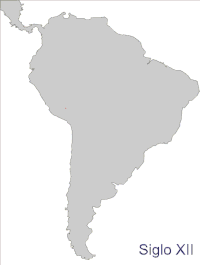Inca army
As the Inca Empire grew, an army created by a loose confederation of peasant warriors was replaced by one of professional officers.
[5] Inca battalions contained permanent staff (generals and officers) and non-permanent personnel composed of drafted hatun runas (common men), who would be serving their military mit'a public service, comparable to mandatory military service or the draft.
This military caste enjoyed several privileges, with the state paying for their food, clothing and housing costs, as well as supplying gifts such as coca, jewellery, and wives.
Women would take care of cooking and repair the soldiers' clothes and, after battles, would attend the wounded and help bury the dead.
A group of priests would also be attached to the army units, to pray, make sacrifices, and try to weaken the opposing force by casting spells before and during battle.
The soldiers were armed and dressed according to their tribe with animal skins, fabric shields, feathers, jewels or body paints.
Inca government officials would perform a careful study of the conquered zone to ensure the achievement of these objectives.
These fortresses also controlled the main communication routes and were constructed in easily defensible locations such as in mountains, on the tops of hills or at the side of a river or road.
[17] Before the hand-to-hand combat would start, to break the enemy's lines the soldiers used ranged weapons (slings, arrows and short spears).
This wide variety of men would prove both an advantage (numerical superiority and specialized soldiers for different terrain) and a disadvantage (lack of cohesion between army battalions).
[19] Most opponents of the Inca in the region were poorly organized and after breaking formation would perform mass frontal charges.
The Inca army, by contrast, was so well disciplined that it very rarely broke formation and was able to effectively repel ambushes in the jungle, desert, mountain and swamp terrains.
Groups of nobles were sent to negotiate treaties of peace and, on a number of occasions, the servants of these emissaries were spies that tried to bribe the enemy officers so that they would betray their kin by retreating during a crucial moment in the battle.
After the annexation and division of a conquered territory, settlers from other parts of the Tawantinsuyu were sent to reinforce the loyalty to the empire (Mitma) also to teach them new techniques of agriculture, metallurgy, etc.
Inka engineers understood the environment and built colcas to take advantage of natural airflow to keep stored items fresh.
Some main characteristics generally featured in the kallankas are: several doors, niches, windows, gables and gable roofs, elongated rectangular ground plan, interior usually without divisions (continuous space), presence of internal posts or columns to support the roof (in the case of large structures), several doors placed at intervals in one of the long walls that lead to a square.
[22] Due to its importance as political or military administrative centers, several functions have been attributed to it such as: Headquarters or barracks for the soldiers of the empire,[23] places of public meeting or assembly,[24] palaces or lodgings for important individuals,[25] or finally as a multi-role building (it had to be adapted to different purposes and situations).
With the exception of the great strongholds in the Cuzco area, the structure and layout of the Inca fortresses are surprisingly uniform, indicating that they were planned and constructed by a central authority.
The pukaras were usually situated on hills; built on concentric terraces that spiraled up the hillside to surround a barracks complex.
The upper part of the retaining wall of the terraces had a stone parapet that protected the defenders from enemy projectiles (called "Pirqas",[29] walls of rustic construction made of raw stone, with a maximum height of about 1.5–1.7 meters (5.0–5.6 feet) and a width of about one meter).
The hilltop complex was surrounded by its own wall, large pukaras could include a platform for a temple dedicated to the sun god Inti; turrets and small towers with stone gates that functioned as observatories, lodgings for the commander of the square, his troops and some priests and Colcas where food, clothing and armament for the garrison were kept, as well as several rooms.
The tambo (from quechua "Tampu") was a building located next to a road used by travelling state personnel as a shelter and storage center for administrative and military purposes.
People from nearby communities were recruited to serve in the tambos as part of the work system called mit'a.
This would make total sense if we take into account that it would symbolize the andean duality (Hanan and Hurin) present in all the Inca organization.
Each Inca soldier carried a different kind of weapon according to his origin in the ayllu, the quality of the decoration as well as the metal that made it up, depended on his military rank (See table above).
[47] Peaceful conquest was possible when a curaca agreed to recognize the Sapa Inca as his emperor in return for a number of benefits.
These benefits could include gifts, investment in public works, recognition at their investiture, interchange of women to establish family ties, etc.
The defeated leader would be executed and, depending on the degree of their rebellion, the subjects would either be moved to a distant place or, in extreme cases, totally annihilated as a punishment to avoid future uprisings.
Initially, the Inca soldiers feared the horses and firearms of the Spanish, with this intimidation reducing their fighting efficiency.
Soon, however, the soldiers forgot their fears and some Inca battalions even fought with swords and Spanish weapons and as cavalry units.










